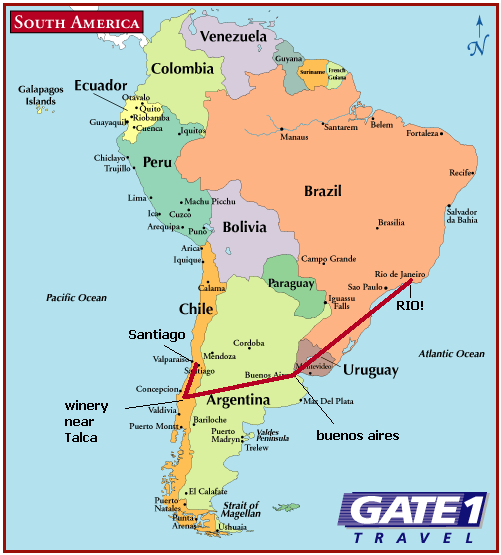 These photos were taken from the balcony of my 24th floor hotel room in Rio de Janeiro. They were taken at 7:45 am as the rising sun beamed down over the city. The beaches in the far distance are first Leblon and then Ipanema. These are the nicer but more touristy parts of Rio (good shopping, food and entertainmen) If you continue around that far bend in the distance, the coast back in and forms another long beach, the famous: Copacabana. It cannot be seen in the photos. Today, after a vigorous swim followed by a large breakfast with a wide array of fruit to choose from -
These photos were taken from the balcony of my 24th floor hotel room in Rio de Janeiro. They were taken at 7:45 am as the rising sun beamed down over the city. The beaches in the far distance are first Leblon and then Ipanema. These are the nicer but more touristy parts of Rio (good shopping, food and entertainmen) If you continue around that far bend in the distance, the coast back in and forms another long beach, the famous: Copacabana. It cannot be seen in the photos. Today, after a vigorous swim followed by a large breakfast with a wide array of fruit to choose from -  all of which is wonderful because it grows locally in this tropical climate, Philip and I went for a long stroll down the boardwalk all the way to Copacabana (about 4 miles). There is a wonderful atmosphere along the beach: even on a Tuesday at 10:30 am, the pathway was crowded with joggers, powerwalkers, skateboarders and cyclists. The weather was wonderful - like LA but maybe a tad bit warmer (remember, it is winter here now!). The sun was strong but relaxing and there is a very active, energetic feel amongst the locals and tourists alike. There are bike and running paths crisscrossing the entire city. Rio is completely different from Buenos Aires. Just think of the differences between LA and NYC and you will understand. The path along the beach reminded both of us of Santa Monica and Venice Beach - every once in a while, we came across a collection of young men doing pull-ups, dips and acrobatics on a variety of jungle gym like structures. There are cafes and kiosks every 200 yards offering shaded tables and the typical beach refreshments: fresh coconuts, beer, cocktails and ice cream. Across from the beach, the opposite side of the street is lined with hotels, high rise apartments and first-floor retail all of which looks like it was built at least twenty years ago but has been kept in decent condition. In some senses, Rio also feels very much like Acapulco as the beaches cove inwards and there are a few small islands in the distance.
all of which is wonderful because it grows locally in this tropical climate, Philip and I went for a long stroll down the boardwalk all the way to Copacabana (about 4 miles). There is a wonderful atmosphere along the beach: even on a Tuesday at 10:30 am, the pathway was crowded with joggers, powerwalkers, skateboarders and cyclists. The weather was wonderful - like LA but maybe a tad bit warmer (remember, it is winter here now!). The sun was strong but relaxing and there is a very active, energetic feel amongst the locals and tourists alike. There are bike and running paths crisscrossing the entire city. Rio is completely different from Buenos Aires. Just think of the differences between LA and NYC and you will understand. The path along the beach reminded both of us of Santa Monica and Venice Beach - every once in a while, we came across a collection of young men doing pull-ups, dips and acrobatics on a variety of jungle gym like structures. There are cafes and kiosks every 200 yards offering shaded tables and the typical beach refreshments: fresh coconuts, beer, cocktails and ice cream. Across from the beach, the opposite side of the street is lined with hotels, high rise apartments and first-floor retail all of which looks like it was built at least twenty years ago but has been kept in decent condition. In some senses, Rio also feels very much like Acapulco as the beaches cove inwards and there are a few small islands in the distance. The topography of the city is incredible. Large mountains, cliffs and hills rupture upward between dense urban life. Favellas (shanty towns) as well as nicer residential neighborhoods trickle down the sides of hills - reserving the peaks for churches, parks, and statues. In one photo, you can see the Corcovado (The Christ Redeemer) poised atop the tallest mountain overlooking Rio. It was recently named one of the new seven wonders of the world.
The people in Rio are diverse. There are many blacks. Many more mixed. And a large collection of tourists as well. The women are beautiful. The people all seem to be fit. There is some poverty on the streets - when walking through the city streets, we were approached by a few young beggars.
We returned around 2 pm and ate at our hotels beachside Churrascaria - all you can eat steak, chicken, lamb and pork served on skewers by waiters walking between tables. The real Fogo de Chao. Its now 7 pm and we are heading out to listen to Samba.
By the way, Mom and Dad, contrary to what everyone says, this place is not as dangerous as it seems. Don't worry. We'll be safe, smart and still have a great time.






